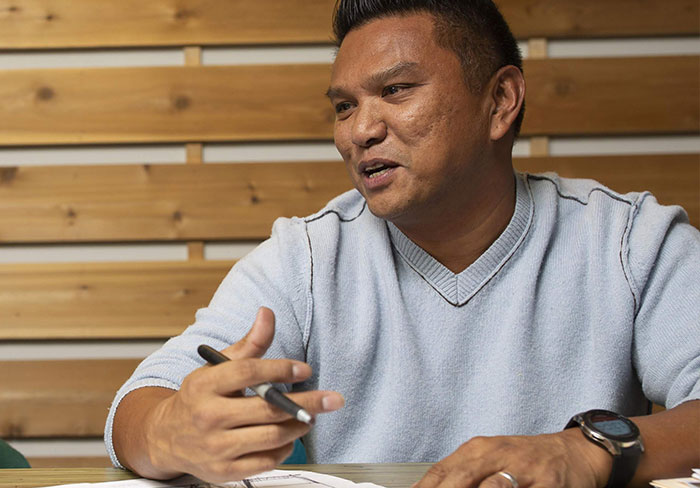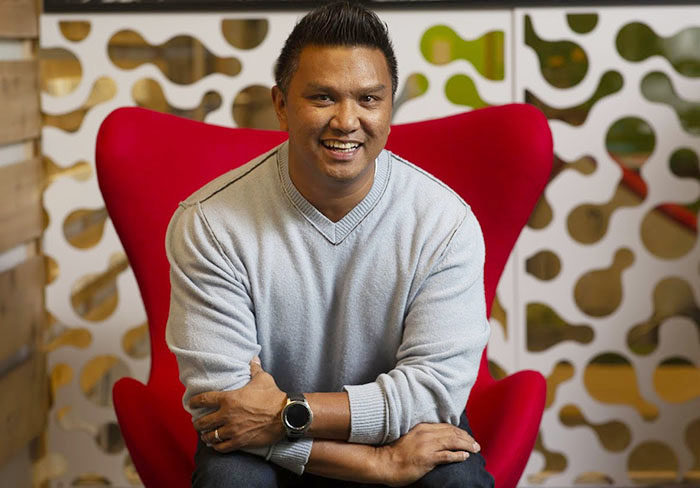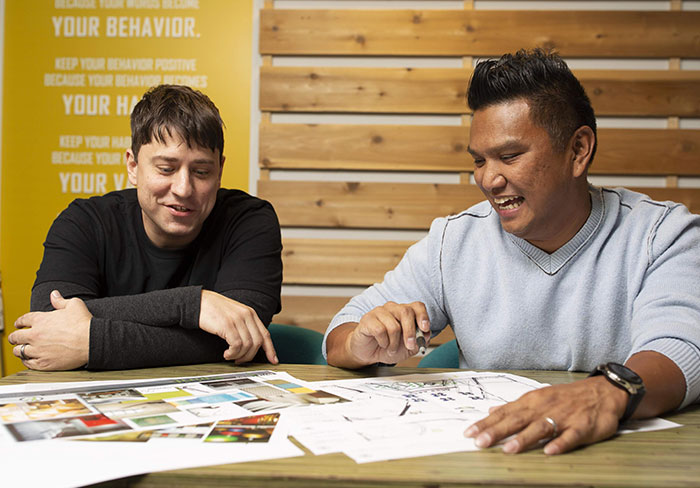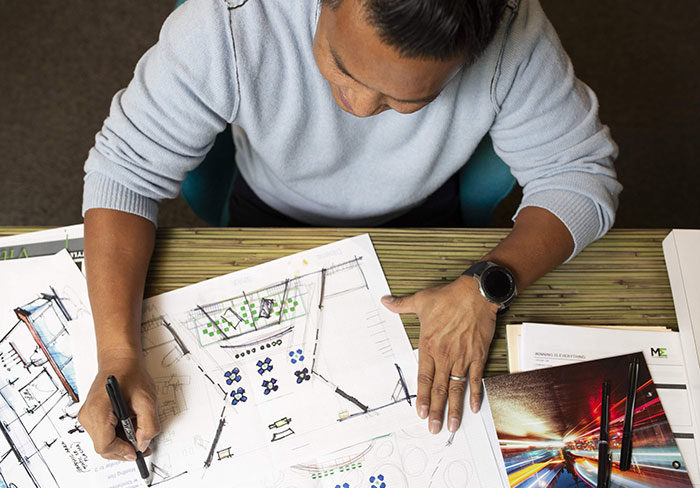
Q&A with Motif Founder & Lead Designer, Ben Guy, on Exhibit & Event Design
We sat down with Ben Guy to get his insights into what makes for great design. Our interview with him covers everything from collaboration with Motif’s clients to where he finds inspiration in the design process.

Ben Guy
Q: Let’s start with a little bit of background on you. Tell us how you got into exhibit and event design. What is the “Story of Ben” leading up to where you are today?
Ben: I grew up watching my uncle design exhibits. He’s obviously “old style.” He drew perspectives by hand and did marker renderings. Design sketches were all over the place. I didn’t know back in the day that I would actually be taking it up, but that’s how I got exposed to it.
Then I went to college at Northern Illinois University where they offered an architectural degree, with an emphasis on interior architecture. I picked that up knowing that most of my colleagues would work at retail design firms. Exhibits really didn’t come into play. As I moved through the program, I began focusing more on hospitality design — restaurants, hotels, lobbies, meeting rooms and so forth.
After college, I did that for a couple of years in a small — but very design oriented — firm. They did a lot of Hyatt, Sheraton and Double Tree Hotels. I was designing everything from their presidential suites to guest rooms to lobbies to the restaurants inside the hotels. It was a small enough firm that I wasn’t just doing the “gopher jobs.” I was doing design work right away. It was a great experience, lots of stress, and long hours.
After a few years, I got a call from an ad agency that wanted to start designing spaces for clients’ trade shows. I was looking for something different, so I became the one man that they brought in to grow that part of their business. I didn’t really think about my uncle’s influence at the time, but it must have stuck with me. This was the start of my event design career.
After that, I worked at custom exhibit firms, gaining more experience. I taught myself how to use computer rendering software as that became the norm. And I landed a job at Exhibit Group, which was the largest firm in the country back in the day. I became a senior designer and handled maybe $10-20 million worth of projects in a given year by myself. Over 3-4 years there, I started making a name for myself in the industry. I became known for designing some pretty cool stuff. People kept asking if I was going to go on my own, so I started dabbling in freelance design while I was working for Exhibit Group.
I felt like, at the big firms, there wasn’t enough of a focus on design. It was more like, “You have X project. Let’s crunch it. Make the most out of it.” I didn’t want to be in that environment, so I went on my own in about 2001. By that time, I knew a good amount of account executives that were at different companies. I didn’t even have to market myself as a freelance designer. People kept calling me. A couple of those guys were Dave Hibel and Dieter Hinkelmann, who became my partners here.

Ben and his partner, Dave Hibel, working out design options for an upcoming client pitch.
Q: So that was the beginning of Motif?
Ben: Correct. That’s basically how it started. When 2008 came along, and the economy went downhill, companies that went to tradeshows weren’t getting what they were looking for in these big firms as far as their investment. So we felt like we could offer more to these companies by doing “custom rental programs.” This is where we design it, build it and offer it to clients as a rental. It is strictly custom design properties, but it’s built to be reconfigured as needed. It gives our clients a different customized look while keeping the cost down, and that’s how we’ve been doing it ever since.
Q: So, the business emerged from that need—how to find a new way to deliver more value for the client’s dollar?
Ben: Exactly right. It made sense then, and it still does.
Q: A big part of what makes Motif different is how you collaborate with your clients and make it a partnership. What makes for successful collaboration when it comes to design?
Ben: What we do well is listen. It’s about learning what they are looking for. They don’t necessarily tell us what they want, but they emphasize what they need to accomplish. And from there, we can present ideas for an environment that hits on those points. There is a time for us to present, but at the start, if we listen properly instead of talking about our ideas, I find it gets better results.

Ben on the value of putting pen to paper: "I scratch. I scribble. They are just lines. If you are less precious with it in the beginning, you can find something unexpected."
Q: What are sources of inspiration for you in your design process? How do you keep inspired?
Ben: A lot of designers don’t get how your environment should be used to inspire you. I have a lot of design books — architectural design books, magazines, and even graphic books. I look at graphic layouts, and I visualized them in simple forms, and I use that to form shapes, structures, and layouts within my space. I also sometimes use nature. The negative spaces in between buildings, trees, and organic life. From there it’s pen to paper. Most people are shy about putting a line down onto paper. I’m not. I scratch. I scribble. They are just lines. If you are less precious with it in the beginning, you can find something unexpected. I start work on it for an hour. If it doesn’t work out, that’s ok. Rip it up and start fresh. Keep going.
Q: What are some exciting trends that you see happening in the world of exhibit design?
Ben: I think it still has a way to go, but 3D printing mixed with AV and technology is exciting. Specifically, I’m talking about the combination of structure and technology. Not many people support technology and combine it with the architecture as a whole yet. In the past, it was about composing architecture that speaks to the client’s brand and messaging. Right now, all you see are AVs being slapped onto a wall. It can be so much better. In the best environments, it all works together. The tech can bring in multiple messages, and the structure can accentuate it in a “less is more” way.
Q: What are some characteristic differences between good design and great design?
Ben: For us, how we are great as a company is how we utilize different forms, shapes, structures, and materials that can relate to their budget. We can spin a design on an existing structure and blend that in with customized elements, so we are not only hitting the look and feel that the client is striving for but also not exceeding their budget.
Q: So for Motif, a big part of “great” is making the best design affordable?
Ben: Yes. For example, imagine a client that has $100,000 and for that, we give them a uniquely positioned experience that would have cost them $300,000 at another vendor. That doesn’t just happen. There’s problem-solving that goes into that. Lots of creativity. Lots of design processes that we’ve developed to make it possible. I’d call that great design. Wouldn’t you?

